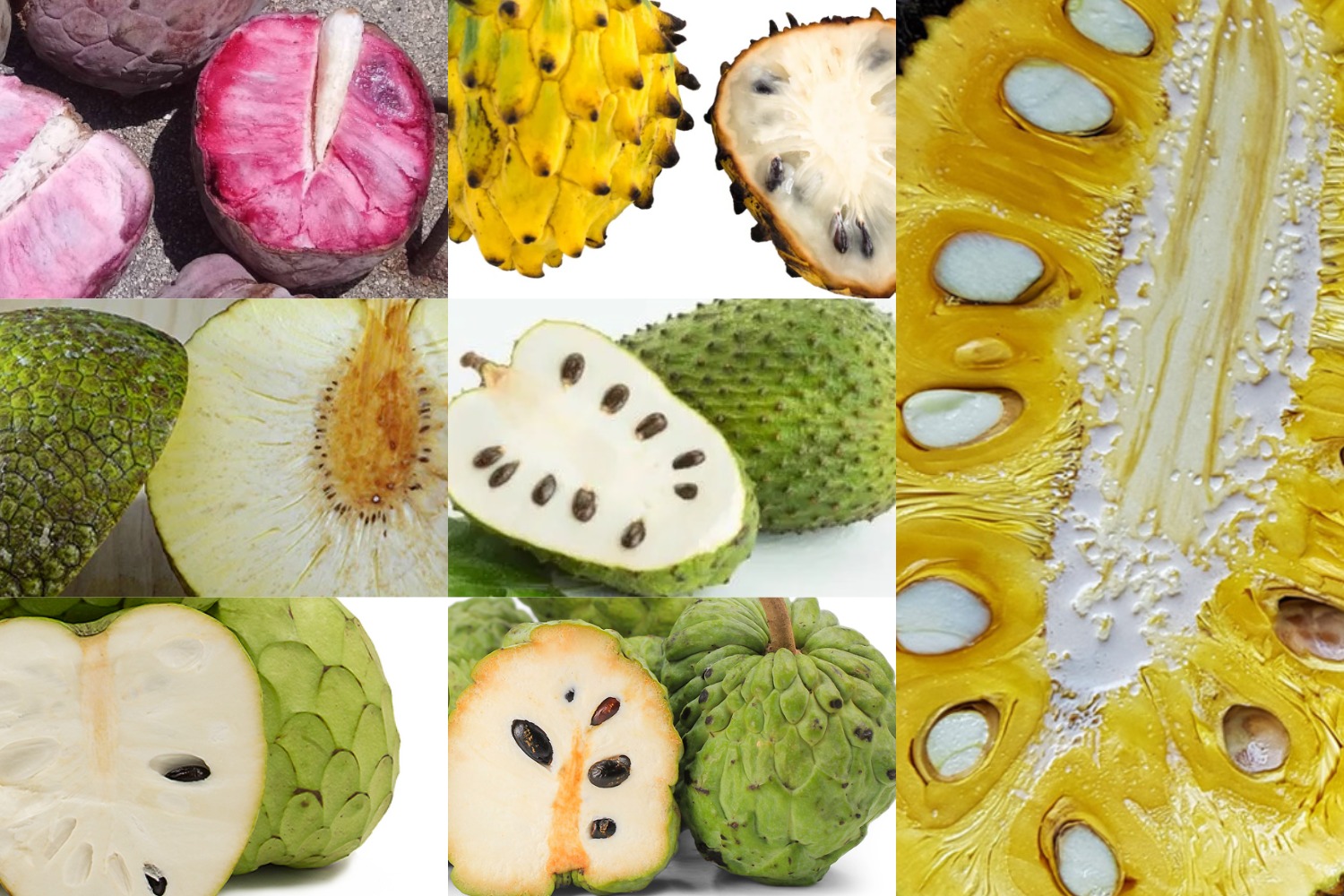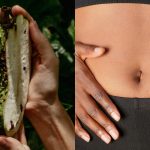Fruits that look like soursop, what are they? At first glance, soursop can look like a fruit plucked straight from science fiction. Its spiky green exterior, soft white pulp, and intense aroma make it impossible to ignore. For those who’ve only seen it once, the image lingers: somewhere between alien and edible. But soursop is not entirely unique in the botanical world. There are several fruits across the globe that mimic its appearance or texture in surprising ways. Some hail from the same plant family, while others evolved similar traits in different regions for entirely different reasons.
Understanding these lookalikes isn’t just a curiosity. It’s a need, especially if you like to travel and to try local food and different fruits. Let’s examine the most compelling fruits that visually or texturally resemble soursop and why they matter.
Soursop: The Baseline
Before comparing, it’s helpful to define what soursop looks and feels like. Native to tropical regions of the Americas, soursop (Annona muricata) belongs to the Annonaceae family. It’s covered with soft, pliable spines that give it a slightly threatening look. Inside, the pulp is creamy, segmented, and white with large black seeds embedded throughout. Its taste is often described as a medley of pineapple, strawberry, and citrus.
This combination of spiny exterior and custard-like interior isn’t unique to soursop. Several other fruits exhibit similar features, either due to shared ancestry or ecological coincidence. Time to start creating our list of fruits that look like soursop! Whether you’re sourcing ingredients, planting a tropical garden, or traveling through fruit-rich regions, this breakdown will help you identify what’s in front of you.
And the first one is … Graviola. Graviola is simply another name for soursop, often used in Brazil and in the context of health supplements. If someone presents “graviola” as a separate fruit, it’s a branding issue, not a botanical one. (Same species as soursop, different name).

1. Cherimoya (Annona cherimola)
Often dubbed the cousin of soursop, cherimoya is a fellow member of the Annonaceae family. Its outer appearance is a bit smoother — think more like scales than spikes — but the interior texture and taste are remarkably similar. Indigenous to the Andes, cherimoya grows at higher elevations and has earned nicknames like “custard apple” in many cultures.
Unlike soursop’s slightly aggressive look, cherimoya has a more subdued exterior but carries a comparable rich, creamy pulp. In blind taste tests, many people even prefer cherimoya for its smoother mouthfeel and more balanced sweetness. Mark Twain famously called it “the most delicious fruit known to men.” Botanically, it’s one of the closest relatives to soursop and has even been hybridized with it in some agricultural experiments.
- Creamy, white flesh with black seeds
- Belongs to the same plant family (Annonaceae)
- Often described as a “custard fruit”
Similarities:
- Skin is smoother and has overlapping scales rather than soft spikes
- Slightly smaller and rounder than soursop
- Typically grown in cooler, high-altitude climates like the Andes
Differences:
Quick tip: If the skin looks like it has fingerprint-like indentations rather than pointed tips, it’s probably cherimoya.
2. Atemoya (Annona cherimola × Annona squamosa)
Atemoya is the result of a deliberate cross between cherimoya and sugar apple. It was first developed in the early 20th century in Florida in an attempt to produce a fruit that combined the resilience of sugar apple with the flavor profile of cherimoya. The result? A fruit that is nearly indistinguishable from soursop to the untrained eye.
Its skin bears slightly raised scales and faint ridges, echoing the textured surface of soursop. The flesh is white, sweet, and custard-like, with less acidity than soursop but similar seed distribution. Atemoya is increasingly grown in Southeast Asia and Australia and is prized for being more cold-tolerant than soursop, making it a feasible substitute in borderline tropical regions.
- Creamy flesh, sweet flavor
- Hybrid of cherimoya and sugar apple, making it genetically close to soursop
- Seed-filled interior with a segmented texture
Similarities:
- Smaller and rounder
- Skin has faint, smooth ridges instead of spikes
- Often cultivated in subtropical regions such as Taiwan, Israel, and parts of Florida
Differences:
Quick tip: Atemoya ripens faster and has a more compact shape compared to the long, oval form of soursop.
3. Sugar Apple (Annona squamosa)
If soursop is the heavyweight in the Annonaceae family, sugar apple is its smaller, more compact cousin. Known for its segmented green bumps and relatively soft skin, sugar apple is another tropical fruit with an interior that mirrors soursop’s texture. The segments separate easily by hand, revealing creamy flesh inside.
Sugar apple is much smaller than soursop and contains more seeds per ounce of pulp, making it slightly more labor-intensive to eat. However, its flavor is intensely sweet, and in some regions, it’s preferred for its manageable size and quick ripening. In street markets across Southeast Asia and Latin America, sugar apple is often mistaken for soursop by visitors unfamiliar with either fruit.
- Sweet, creamy flesh
- Similar taste profile
- Belongs to the same botanical family
Similarities:
- Small, baseball-sized fruit with very distinct, knobby segments
- Skin is thin and fragile
- Far more seeds in proportion to the pulp
Differences:
Quick tip: If it looks like a pinecone and comes apart easily in your hand, it’s likely a sugar apple.
4. Jackfruit (Artocarpus heterophyllus)
This is where the resemblance becomes a matter of scale and misunderstanding. While jackfruit belongs to an entirely different botanical family (Moraceae), its spiky green exterior often draws comparisons to soursop. However, jackfruit is typically massive, with some weighing over 80 pounds.
Unlike soursop’s segmented soft pulp, jackfruit contains fibrous pods around large seeds. The texture is chewy rather than custard-like, but the visual similarity of their skins leads many people unfamiliar with tropical produce to confuse the two. Interestingly, unripe jackfruit is used as a meat substitute due to its texture, while soursop is strictly used in desserts or juices.
- Large, spiny green fruit
- Distinct tropical scent
- Frequently mistaken for soursop due to size and skin
Similarities:
- Belongs to the fig family (Moraceae), not Annonaceae
- Flesh is fibrous and yellow
- Grows much larger (some exceed 80 pounds)
Differences:
Quick tip: If the flesh is stringy and yellow and the fruit smells like bubblegum or durian, it’s jackfruit.
5. Rollinia (Rollinia deliciosa)
Sometimes called “biriba,” rollinia belongs to the same family but isn’t as globally well-known. Native to the Amazon basin, this fruit wears a distinctly spiky skin — almost identical to soursop, though more symmetrical and geometric in shape. The spikes are triangular, not conical, creating a distinct visual pattern.
Inside, rollinia is strikingly soft and jelly-like, often described as “lemon meringue” in flavor. It spoils very quickly, which is likely why it hasn’t become a widespread commercial fruit. However, in Brazil and Peru, it’s considered a delicacy. Its visual similarity to soursop is uncanny enough that in some markets they’re sold side by side, confusing even locals.
- Soft, yellow-green skin with flexible spines
- White, custardy pulp
- Short shelf life and strong aroma
Similarities:
- Grows primarily in the Amazon basin
- Often described as having a lemony flavor
- Spines are more geometrically spaced
Differences:
Quick tip: Rollinia has yellowish skin and a more spherical shape than the heart-like soursop.
6. Breadfruit (Artocarpus altilis)
Closely related to jackfruit, breadfruit has a similar exterior texture and is often mistaken for soursop at a glance. However, it lacks the spines or pronounced bumps and has a smoother green surface. Breadfruit’s starchy interior is more akin to a potato than a fruit and is typically roasted or boiled rather than eaten raw.
Still, when immature, breadfruit has a green, irregular texture that can mirror the appearance of a young soursop from a distance. In regions where both grow, locals differentiate them easily, but visitors frequently misidentify one for the other.
- Similar skin texture, especially when unripe
- Grows on large tropical trees
- Green, round to oval shape
Similarities:
- Flesh is starchy, not sweet
- Usually cooked, not eaten raw
- Lacks the pointed spikes of soursop
Differences:
Quick tip: If it’s being roasted or boiled in a savory dish, it’s probably breadfruit.
7. Ilama (Annona diversifolia)
Ilama is a lesser-known member of the Annonaceae family and shares a close botanical relationship with soursop. Native to Central America, especially southern Mexico and Guatemala, ilama typically grows in warm, dry lowlands and is prized locally for its soft, aromatic pulp. The fruit’s exterior is conical to heart-shaped, often covered with smooth, scale-like sections that resemble the segmented surface of cherimoya more than the spiny skin of soursop. The skin color varies from pale green to pinkish-purple, depending on the variety. Inside, the flesh is creamy and can be white or deep pink, with a sweetness that has subtle hints of berry or banana.
While ilama is rarely exported or seen in mainstream markets, it’s an important regional fruit where it grows. Its similarities to soursop lie mainly in the shared custard-like pulp and large black seeds, but ilama is often more fragrant and slightly denser in texture. Because it bruises easily and ripens quickly, ilama is usually eaten fresh or made into desserts on the day it’s harvested. Its name is derived from the Nahuatl word ilamatzapotl, meaning “old woman’s sapote,” a nod to its indigenous roots and long-standing cultural value.
- Closely related species
- White or pink flesh with custard texture
- Sweet with hints of berry or banana
Similarities:
- Grown mainly in Central America
- Skin is smoother, sometimes with a pink or lavender hue
- Rarely exported due to perishability
Differences:
Quick tip: Color is your clue here — if you see pink or lavender on the skin or flesh, it’s not soursop.

Patterns in Evolution and Agriculture
What ties all these fruits together is not just visual similarity but evolutionary context. The phenomenon known as “convergent evolution” explains why fruits from different botanical families may develop similar features — spiny protection against herbivores, light-colored pulp for seed dispersal by animals, or segmented flesh for easier propagation.
According to a 2019 report by the International Tropical Fruits Network, global demand for lesser-known fruits such as soursop, atemoya, and rollinia has grown by over 12 percent annually in urban markets over the last five years. As global cuisine becomes more varied, more people encounter these fruits not just in their native regions, but in restaurants, juices, and frozen products.
The Bottom Line
While soursop may have the most media attention thanks to its unique appearance and flavor, it shares its features with a host of other fruits. Cherimoya, sugar apple, atemoya, rollinia, jackfruit, and breadfruit all echo parts of what makes soursop so recognizable. Whether through genetic relation or environmental adaptation, they form an interconnected group of tropical fruits that challenge our assumptions about what’s unique in nature. Understanding these similarities isn’t just an academic interest; it broadens culinary potential and deepens agricultural resilience across regions.


